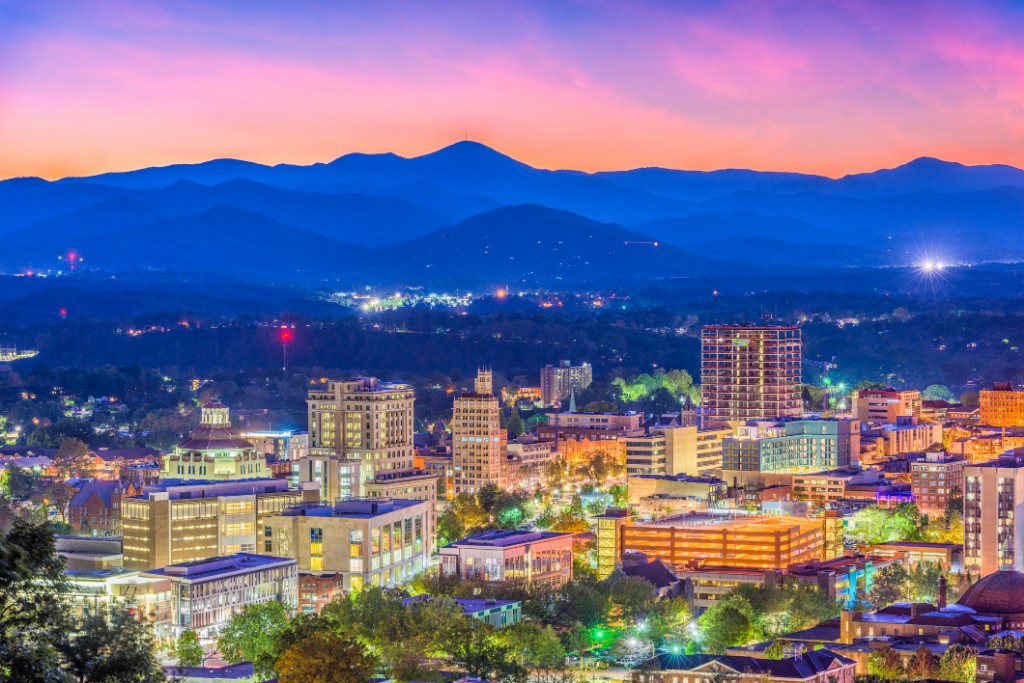
Asheville
Asheville is the largest city in Western North Carolina and serves as the cultural and commercial hub of both Buncombe County and the entire region. This has long been true. Situated in what was once a part of the Cherokee nation, Buncombe County was established in 1791 from parts of Burke and Rutherford counties with a small log cabin courthouse at the site of what is today Pack Square serving as its administrative heart. Initially known as Morristown, the city’s name was changed to Asheville in 1797 in honor of the governor of North Carolina, Samuel Ashe. Buncombe, meanwhile, had been named after Colonel Edward Buncombe, who fought in the Revolutionary War. Asheville remained a modest settlement for much of the nineteenth century. Some tourists were attracted to the area’s natural beauty, but a far larger number of visitors were livestock drovers traveling between Tennessee and South Carolina along the Buncombe Turnpike. Asheville was a popular stop because it sat midway along this vital trade route, but it attracted a limited number of permanent residents and never saw a significant population boom. This changed with the arrival of the railroad in 1880. The population of the city skyrocketed from 2,616 at the start of the decade to 10,235 by 1890. The surge in population was accompanied by an increase in tourism, as people from around the world came to Asheville looking for mountain adventure, to relax, or to restore their health. One of the most notable tourists was George Washington Vanderbilt II, whose Biltmore Estate (constructed between 1889 and 1895) continues to be the largest privately owned house in the United States and one of the city’s most important tourist attractions. This includes the estate’s grounds and gardens, which were designed by Frederick Law Olmstead, the landscape architect behind New York City’s Central Park. Tourism continues to be a major source of revenue and employment for Asheville. In fact, even the minor league baseball team is named the Tourists. Meanwhile, the historic architecture of downtown Asheville is home to dozens of quaint shops and world class dining options, as well as landmarks like the Asheville Art Museum and the Grove Arcade, an Art Deco treasure that has been restored to its former beauty and is now home to a cross of sophisticated bars, restaurants, and stores for local artisans. Downtown is also where many of the city’s most well-known venues are located, including the Orange Peel, Rabbit Rabbit, and Harrah’s Cherokee Center, which attract major touring bands. The outdoor venue Salvage Station, located on the nearby bank of the French Broad River, also attracts larger acts. Asheville is an expansive city with dozens of neighborhoods to explore. To the west of downtown and along the French Broad River is the city’s River Arts District, where warehouses and mills are being converted into galleries and studio spaces for artists. The district is also home to hip cafes, restaurants, breweries, and a new greenway with gardens and public art installations. Meanwhile, to the south of downtown is the South Slope Brewery District, which draws in beer enthusiasts from around the world who want to see why Asheville is always in the running for the best beer city in the U.S. However, Asheville is far more than a destination for tourists. The city’s progressiveness and embrace of local arts, music, beer, cuisine, and crafts is now attracting people from all walks of life who want to be part of the community. Many eventually settle well outside of the buzz of downtown and in neighborhoods like stately Montford, tranquil Lakeview Park, historic Kenilworth, or quirky West Asheville. Each of these neighborhoods has their own flavor and helps to make Asheville such a unique and special place.Sorry we are experiencing system issues. Please try again.
